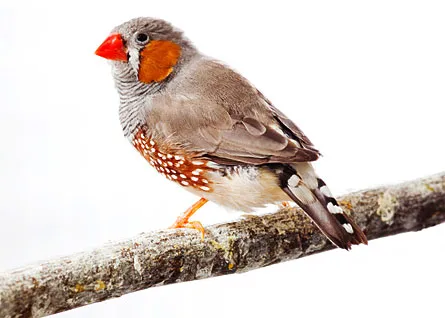- More than 2 years ago
Zebra finches have something to tweet about. The little songbirds’ genetic instruction book has just been deciphered.

An international team of scientists announced the accomplishment in the April 1 Nature. Zebra finches are the first songbirds and the second bird, after the chicken, with a completely decoded genetic blueprint. Contained within the finch’s DNA could be clues to how songbirds learn vocal information and use songs in social situations, a model for human language and communication.
Whales, dolphins, some bats and several other species of birds also learn vocally, but the mouse-sized zebra finch has become a model system for studying the process in the laboratory. Male zebra finches memorize their fathers’ songs and practice singing the song for a month or two. Once learned, a male’s song is his signature. Unlike other songbirds that can change their songs, he sings his for life.
Discovering the molecular mechanisms behind how songbirds learn their songs could also help scientists better understand human communication disorders such as autism and stuttering, says David Clayton, a neurobiologist at the University of Illinois at Urbana-Champaign, who was one of the leaders of the study.
Neuroscientists have studied zebra finches for years to learn which parts of the birds’ brains become active as the animals hear and learn new songs. The new genetic information will add molecular details to help scientists better understand vocal learning, says Allison Doupe, a neuroscientist and psychiatrist at the University of California, San Francisco. She was not involved in the new study, but says the genetic information is a welcome tool for researchers who study the finches.
“Getting this model up to the next stage in genetics … is good. It’s great. I think everyone is very excited,” Doupe says.
In the new study, the researchers decoded DNA taken from a male zebra finch called Black 17. The bird was chosen because he is an average zebra finch male, says Clayton.
Comparing Black 17’s genetic blueprint to that of chickens revealed several notable features in the birds’ genomes. For instance, in zebra finches, immune system genes of the major histocompatibility complex are scattered across several chromosomes, while chickens and humans keep such genes in clusters on a single chromosome.
The researchers also uncovered evidence that some genes encoding ion transport proteins are evolving more quickly in zebra finches than in chickens. Ion transport proteins help regulate communication between neurons, and activity levels of some of the quickly evolving genes dip when zebra finches hear new songs, the study shows.
Analyses of gene activity in zebra finches’ brains showed that the activity of more than 800 genes changes when the birds sing. The finding supports a previous study by Clayton’s group, which showed that a large number of RNA molecules change levels when a bird is listening to a song.
The new genome sequence revealed that many of those RNAs are regulatory molecules known as noncoding RNAs. Levels of one of those molecules, a tiny snippet of RNA known as microRNA-124, drop rapidly when a bird hears a new song, the researchers report. MicroRNAs are known to regulate production of proteins and have been suggested to be important for brain function (SN: 03/01/2008, p. 136), but this is the first time a microRNA has been shown to respond to a particular thought process, Clayton says.
The researchers hope to expand their genetic studies to include genomes from other vocal-learning bird species, including parrots and other species of songbirds.






